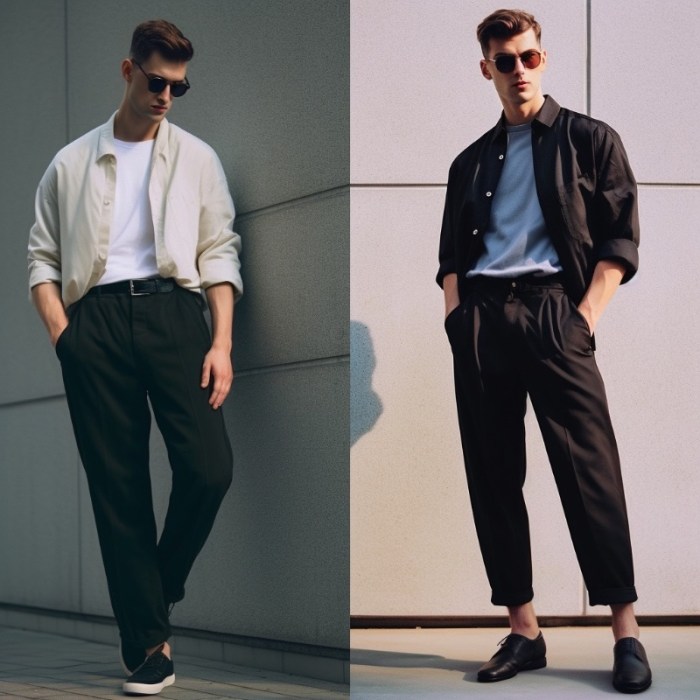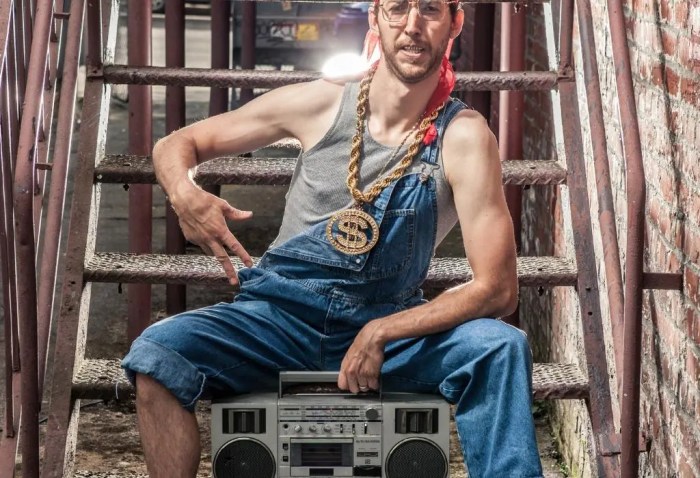Key Garments and Accessories

1960s fashion for men – The 1960s witnessed a significant shift in men’s fashion, moving away from the more conservative styles of previous decades. This era embraced a broader range of styles, influenced by youth culture, evolving social norms, and international trends. Understanding the key garments and accessories helps to paint a complete picture of the decade’s sartorial landscape.
The essential pieces of a typical 1960s man’s wardrobe reflected a blend of formality and informality, often depending on the occasion and personal style. Fabrics played a significant role in defining both the look and feel of the era’s clothing.
Essential Garments
The core of a 1960s man’s wardrobe included well-tailored suits, often in lighter colors or bolder patterns than those of previous decades. These were complemented by casual shirts, knitwear, and trousers. The slimmer silhouettes of the mod style contrasted with the more relaxed fits favored by other subcultures. For example, a sharply tailored suit in a light grey or even a pastel shade would be a staple for more formal occasions, while a pair of well-fitting corduroy trousers and a casual button-down shirt would be suitable for a more relaxed setting.
Fabric Choices
The choice of fabric was crucial in conveying both style and social standing. Corduroy, a durable and textured fabric, became immensely popular, often appearing in trousers and jackets, offering a casual yet stylish look. Wool remained a mainstay for suits and overcoats, offering warmth and sophistication. Linen, particularly in lighter colors, provided a summery alternative, reflecting a more relaxed and carefree attitude.
These fabrics, and their varying textures and weights, contributed significantly to the diverse range of styles seen throughout the 1960s.
1960s men’s fashion saw a shift towards more relaxed styles, a departure from the formality of previous decades. This casualization extended to footwear, with a notable rise in popularity of loafers and boat shoes; for a deeper dive into the options available, check out this guide on men’s casual footwear fashion. The overall effect on 1960s menswear was a more comfortable and youthful aesthetic, reflecting the changing social landscape of the era.
Popular Outerwear
Outerwear choices in the 1960s reflected the era’s varied styles. The classic trench coat remained a popular choice, offering a sophisticated and practical option. Leather jackets, particularly those with a biker-style aesthetic, became strongly associated with youth rebellion and counter-culture movements. Car coats, often in wool or gabardine, provided a more refined alternative, suitable for both casual and slightly more formal settings.
The choice of outerwear often signaled a man’s personal style and affiliation with particular subcultures.
Evolution of Footwear
Men’s footwear in the 1960s also underwent a transformation. The classic Oxford shoe remained a staple, but variations in color and style emerged. Chelsea boots, with their sleek and sophisticated design, gained popularity, reflecting the influence of mod fashion. For a more casual look, loafers and boat shoes offered comfortable and stylish alternatives. The choice of footwear often complemented the overall outfit, reflecting both formality and personal style.
A Typical 1960s Outfit, 1960s fashion for men
Imagine a man dressed in a slim-fitting, light grey wool suit, the jacket tailored with a slightly shorter length and narrow lapels. The trousers are sharply creased and worn with a pair of brown leather Chelsea boots. Underneath the jacket, he wears a crisp, light blue button-down shirt, perhaps with subtle stripes. A knitted tie, possibly in a textured pattern or a muted color, adds a touch of casual sophistication.
A subtle pocket square peeks from his breast pocket. This outfit represents a blend of formal tailoring with subtle touches of informality, reflecting the style evolution of the 1960s. He might carry a leather briefcase or a slim satchel, adding to the overall sophisticated yet approachable look.
The Influence of Social and Cultural Factors

The 1960s witnessed a dramatic shift in societal norms and values, profoundly impacting men’s fashion. This period saw the rise of counter-culture movements, technological advancements, and changing economic landscapes, all of which contributed to a revolution in menswear, moving away from the more conservative styles of previous decades. The evolving social climate directly influenced the clothing choices of men, reflecting a broader societal transformation.The burgeoning counter-culture movement played a pivotal role in reshaping men’s fashion.
Rejecting the established norms of the previous generation, young men embraced styles that symbolized rebellion and individuality. This rejection of conformity manifested in clothing choices, leading to the adoption of new silhouettes and fabrics.
The Counter-Culture’s Impact on Men’s Clothing
The counter-culture movement, fueled by social and political upheaval, directly challenged traditional menswear. The clean-cut, conservative look of the 1950s gave way to more expressive styles. The adoption of longer hair, previously associated with rebellion, became a significant marker of this shift. Clothing styles reflected this change, with the rise of looser-fitting garments like bell-bottom trousers, often paired with brightly colored shirts or patterned vests.
This was a stark contrast to the more tailored, structured suits and conservative attire of previous generations. The adoption of denim, initially workwear, into mainstream fashion, signified a move away from formality and toward a more casual and relaxed aesthetic.
A Timeline of Significant 1960s Men’s Fashion Trends
The decade saw a rapid evolution of styles. Early in the decade, the influence of the “Mad Men” era persisted, with tailored suits remaining prevalent, albeit with subtle shifts toward slimmer fits and bolder colors. By the mid-1960s, the counter-culture influence became undeniable, with the rise of mod styles characterized by sharp lines and geometric patterns. The late 1960s saw the increasing popularity of casual wear, including denim, and a greater emphasis on individual expression.
The Role of Advertising and Media in Shaping Men’s Fashion Ideals
Advertising and media played a significant role in shaping the fashion ideals of men during the 1960s. Magazines and television commercials showcased the latest trends, influencing consumer choices and contributing to the rapid dissemination of new styles. Celebrity endorsements further amplified the impact of media, creating aspirational figures whose fashion choices were emulated by a wider audience. The rise of youth-oriented magazines and television programs also played a crucial role in promoting the counter-culture aesthetic and its associated fashion trends.
Historical Events and Their Impact on Men’s Fashion
The social and political climate of the 1960s significantly impacted men’s fashion choices.
- The Civil Rights Movement: Increased social awareness led to a greater acceptance of diversity in fashion, although overt displays of rebellion were often more prominent in the youth counter-culture movement.
- The Vietnam War: The anti-war sentiment influenced fashion choices, with some men adopting more casual and utilitarian styles as a form of protest against the perceived conformity of established society.
- The Space Race: While not directly impacting everyday clothing, the technological advancements associated with the space race subtly influenced design aesthetics, with some designers incorporating futuristic elements into their work.
Color Palettes and Patterns: 1960s Fashion For Men

The 1960s witnessed a vibrant explosion of color and pattern in men’s fashion, reflecting the era’s social and cultural shifts. Moving away from the more muted palettes of previous decades, men’s clothing embraced a wider range of hues and bolder designs, often mirroring the optimism and rebellious spirit of the time. This shift in aesthetic was deeply intertwined with evolving social attitudes and the rise of various youth subcultures.
Dominant color palettes included rich jewel tones like emerald green, sapphire blue, and ruby red. Earthy tones such as olive green, mustard yellow, and burnt orange were also popular, particularly in casual wear. Brighter, more vibrant shades like sunshine yellow and electric blue became increasingly common, especially amongst younger men. The use of these colors often depended on the specific subculture or style being adopted.
For instance, while a Mod might opt for a crisp, clean electric blue shirt, a hippie might favor earthy tones in natural fabrics.
The Prevalence of Patterns in 1960s Men’s Fashion
Patterns played a significant role in shaping the visual landscape of 1960s menswear. Paisley, a swirling, teardrop-shaped motif, was hugely popular, often appearing on shirts, ties, and even suits. Checks, in various sizes and colors, from small gingham to large windowpane checks, offered another versatile option, appearing in both formal and informal garments. Stripes, both thin and bold, were a constant presence, frequently used on shirts, trousers, and knitwear.
These patterns, often employed in bold color combinations, contributed to the overall sense of vibrancy and individuality characteristic of the decade.
Color and Pattern in Different Men’s Fashion Sub-Styles
The use of color and pattern varied considerably depending on the specific subculture or style. Mods, known for their sharp, tailored look, favored clean lines and bold, often contrasting colors, with stripes and checks featuring prominently. Their color palette leaned towards brighter shades of blue, red, and white. In contrast, the hippie aesthetic embraced earthy tones and natural fabrics, often featuring paisley patterns and tie-dye techniques.
The preppy style, while retaining a sense of formality, incorporated brighter colors and patterns than its predecessors, often utilizing subtle checks and stripes in navy, beige, and light blue. The working-class styles of the time often incorporated more subdued color palettes, with patterns used more sparingly.
Expressing Individuality Through Color and Pattern
Color and pattern choices became powerful tools for self-expression during the 1960s. The freedom to experiment with bold colors and unconventional patterns allowed men to showcase their personalities and affiliations. A young man’s choice of a paisley shirt might signal his alignment with the counterculture, while a sharply dressed Mod might use contrasting colors and bold stripes to highlight his style.
This ability to visually communicate identity through clothing was a significant departure from the more conservative fashion norms of previous generations.
A Mood Board: 1960s Men’s Fashion Color Palettes and Patterns
Imagine a mood board divided into sections. One section showcases a vibrant palette of jewel tones: emerald green, sapphire blue, ruby red, alongside a selection of paisley patterns in similar hues. Another section displays a range of earthy tones: olive green, mustard yellow, burnt orange, with examples of checks and stripes in these colors. A third section features brighter, more contemporary colors: sunshine yellow, electric blue, and crisp white, with examples of bold stripes and simple geometric patterns.
Finally, a smaller section shows a more subdued palette of navy, beige, and light blue, with subtle checks and stripes, representing a more preppy style. The overall effect would be one of energetic diversity, reflecting the wide array of styles and expressions found in men’s fashion during the 1960s.
Essential FAQs
What were some common fabrics used in 1960s men’s clothing?
Corduroy, wool, linen, cotton, and various synthetic blends were popular choices, reflecting both functionality and the changing textile industry.
How did the Vietnam War impact men’s fashion?
The war’s anti-establishment sentiment indirectly influenced the rise of more casual and less formal styles, reflecting a broader societal shift.
Were there any significant accessories popular during this time?
Yes, items like pocket squares, patterned ties, leather belts, and certain types of hats were prevalent accessories.
Did 1960s fashion influence any specific modern designers?
Many contemporary designers draw inspiration from the era, often incorporating elements like slim-fitting silhouettes, bold colors, and distinctive patterns into their collections.
